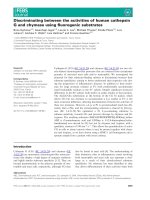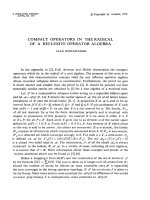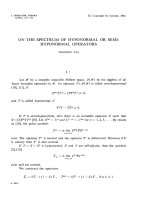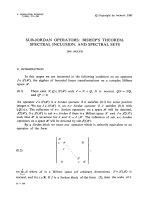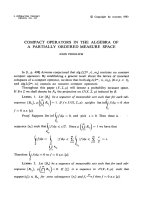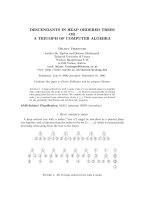Báo cáo toán học: "Bijection between bigrassmannian permutations maximal below a permutation and its essential set" pps
Bạn đang xem bản rút gọn của tài liệu. Xem và tải ngay bản đầy đủ của tài liệu tại đây (103.44 KB, 8 trang )
Bijection between bigrassmannian permutations
maximal below a permutation and its essential set
Masato Kobayashi
Department of Mathematics,
the University of Tennessee, Knoxville, TN 37996, USA
Submitted: Aug 23, 2009; Accepted: May 10, 2010; Published: May 20, 2010
Mathematics Subject Classification: 20F55, 20B30
Abstract
Bigrassmannian permutations are known as permutations which have precisely
one left descent and one right descent. They play an important role in the study
of Bru hat order. Fulton introd uced the essential set of a permutation and studied
its combinatorics. As a con s equ en ce of his work, it tu rns out th at the essential set
of bigrassmannian permutations consists of precisely one element. In this article,
we generalize this observation for essential sets of arbitrary permutations. Our
main theorem says that there exists a bijection between bigrassmanian permutations
maximal below a permutation and its essential set. For the p roof, we make use
of two equivalent characterizations of b igrassmannian permutations by Lascoux-
Sch¨utzenberger and Reading.
1 Introductio n
Bigrassmannian elements play an important role in study of the Bruhat order on Coxeter
groups. They are known as elements which have precisely one left descent and one right
descent. In particular, in the symmetric gr oup (type A), bigrassmannian permutations
have two other equivalent characterizations, one as join-irreducible permutations and one
as monotone triangles with some minimal condition (we will see detail of these in Fact
2.6). Here let us recall the definitions of join and join-irreducibility from poset theory.
Definition 1.1. Let (P, ) be a finite poset and Q ⊆ P . Then consider the set
{x ∈ P | x y for all y ∈ Q}.
If this set has a unique minimal element, we call it the join of Q denoted by ∨ Q. Define
the meet of Q (∧ Q) order dually. P is said to be a lattice if ∨ Q and ∧ Q exist for all Q.
We say that x ∈ P is join-irreducible if whenever x = ∨ Q, then x ∈ Q.
the electronic journal of combinatorics 17 (2010), #N27 1
It is important to note that in a finite poset P , we can write each x ∈ P as the join
of some subsets of join-irreducible elements of P [7, Proposition 9]. Note also that if ∨ Q
exists, then ∨ Q = ∨ Max(Q) where Max means the set of maximal elements of Q.
Unfortunately, the symmetric group S
n
with Bruhat or der is not a lattice. However,
as a lready mentioned, a permutation is bigrassmannian if and only if it is join-irreducible.
Consequently, each x ∈ S
n
is the join of some subsets of bigrassmannian permutations.
More precisely, define
B(x) = {w ∈ S
n
| w x and w is bigrassmannian}.
Then we obtain x = ∨ B(x) in S
n
. However, it is not easy to see B(x) (and Max B(x))
from the usual definition of Bruhat order. Instead we will make use of the set of mono-
tone triangles (say L(S
n
)) because there is a natural identification of permutations with
monotone triangles. It is also helpful that L(S
n
) has the partial order which coincides
with Bruhat order all over S
n
. Furthermore, it is much easier to say which monotone
triangle is larger or smaller (or incomparable). It helps us find B(x) a nd Max B(x). We
will discuss detail in Section 2.
Fulton [5] intro duced the essential set of a permutation as the set of southeast corners
of the diagram of the permutations. As the name “essential” suggests, it is a combi-
natorial object which completely determines a permutation. Eriksson-Linusson studied
its combinatorics for 321-avoiding, vexillary permutations and some enumeration [3, 4].
There is a less-known but interesting property of bigrassmannians described in terms of
essential sets (Section 3).
Fact 1.2. If w is bigrassmannian, then its essential set consists of the only one element.
As far a s the author is aware, it appears only as a consequence of [5, Proposition
9.18]. In fact, the converse is also true, which we will obtain as a consequence of the main
theorem in Section 4. Notice that we can rephrase “w is bigrassmannian” as “Max B(w)
consists of the only one element (w itself)”. From this point of view, the main theorem
gives more general aspect to Fa ct 1.2 fo r even arbitrary permutations.
Theorem. Let x ∈ S
n
and Max B(x) the set of bigrassmannian permutations maximal
weakly below x in Bruhat order, and Ess(x) the essential set of x. Then there exists a
bijection between Max B(x) and Ess(x).
Acknowledgment.
The author would like to thank the anonymous referee for helpful suggestions.
2 Bigrassmannian permutations and monotone tri-
angles
Throughout this article, we treat the Bruhat order on the symmetric groups as the sub-
order induced by the set of all monotone triangles (for the usual definition of the Bruhat
the electronic journal of combinatorics 17 (2010), #N27 2
order in context of Coxeter groups, see [2, Chapter 2]). This section discusses r elation
between this suborder and bigrassmannian (join-irreducible) permutations.
Definition 2.1. For w ∈ S
n
, define the set of left and right descents as
D
L
(w) = {1 i n − 1 | w
−1
(i) > w
−1
(i + 1)},
D
R
(w) = {1 i n − 1 | w(i) > w(i + 1)}.
We say that w is bigrassmannian if #D
L
(w) = #D
R
(w) = 1. Define
B(w) = {x ∈ S
n
| x w and x is bigrassmannian}.
Example 2.2. 34512 is bigrassmannian, but 42513 is not.
As mentioned in introduction, there is an equivalent characterization of bigrassman-
nian permutations in terms of join-irreducicble monotone triangles. We recall the defini-
tion of monotone triangles following [7].
Definition 2.3. A monotone triangle x of order n is a n n(n − 1)/2 -tuple (x
ab
| 1 b
a n − 1) such that 1 x
ab
n, x
ab
< x
a,b+1
, x
ab
x
a+1,b
and x
ab
x
a+1,b+1
for all
a, b. Regard a permutation x ∈ S
n
as a monotone triangle of order n as follows: Fo r each
1 a n − 1, let x
a1
, x
a2
, . . ., x
aa
be positive integers such that {x(1), x(2), . . ., x(a)} =
{x
a1
, x
a2
, . . ., x
aa
}, x
ab
< x
a,b+1
for a ll 1 b a − 1. Then x = (x
ab
) is a monotone
triangle. Denote by L(S
n
) the set of all monotone triangles of order n. We introduce the
partial order on L(S
n
) as x y ⇐⇒ x
ab
y
ab
for all a, b.
Sometimes it is convenient to define x
nb
= b for all x since n-th row is always 1 < 2 <
· · · < n, but we usually omit it.
Example 2.4. As a monotone triangle of order 5, we have
34512 =
3
3 4
3 4 5
1 3 4 5
and 42513 =
4
2 4
2 4 5
1 2 4 5.
Remark 2.5.
(1) In fact, L(S
n
) is a smallest lattice containing S
n
(MacNeille completion of S
n
).
Moreover, for x ∈ L(S
n
), x is join-irreducible in S
n
if and only if so is x in L(S
n
).
See [7, Section 6].
(2) In particular, for permutations x, y ∈ S
n
, we have x y in Bruhat order if and only
if x y as monotone triangles (called tableaux criterion [1]).
Now we observe equivalent characterizations of bigrassmannian permutations (as men-
tioned in introduction) and impor tant consequences.
the electronic journal of combinatorics 17 (2010), #N27 3
Fact 2.6. For w ∈ S
n
, the following are equivalent:
(1) w is bigrassmannian.
(2) w is join-irreducible.
(3) There exist positive integers (a, b, c) such that 1 b a n−1, b+1 c n−a+b
and w = J
abc
where J
abc
is the componentwise smallest monotone triangle such that
a, b entry is c.
Proof. See [6, Th´eor`eme 4.4] for (1) ⇐⇒ (2) and [7, Section 8] for (2) ⇐⇒ (3).
Thanks to Remark 2 .5 and Fact 2.6, for x ∈ L(S
n
), the symbol B(x) still makes sense
as the set of jo in-irreducible elements weakly below x in L(S
n
). Note that J
abc
is the
monotone triangle satisfying the following: For x ∈ L(S
n
), we have
c x
ab
⇐⇒ J
abc
x ⇐⇒ J
abc
∈ B(x)
because of minimality of J
abc
. This observation is useful to identify J
abx
ab
∈ B(x) with
the entry x
ab
showing up in the monotone triangle x.
Next we must understand how to choose maximal elements from B(x). The following
proposition describes all covering relations among bigrassmannian permutations.
Proposition 2.7. For each J
abc
, define
C
1
(J
abc
) = J
a,b−1,c−1
if b 2,
C
2
(J
abc
) = J
a+1,b,c
if c n − a + b − 1,
C
3
(J
abc
) = J
a−1,b−1,c
if b 2,
C
4
(J
abc
) = J
a,b,c+1
if c n − a + b − 1.
In the poset of all bigrassmannian permutations in S
n
, J
abc
is covered by C
i
(J
abc
) if and
only if C
i
(J
abc
) is a valid monotone triangle. More specifically, (i) J
abc
is covered by
C
1
(J
abc
) and C
3
(J
abc
) if and only if b 2. (ii) J
abc
is covered by C
2
(J
abc
) and C
4
(J
abc
) if
and only if c n − a + b − 1. (iii) Furthermore, no other elements cover J
abc
(and hence
at most four elements cover J
abc
).
Proof. Reading described all covering relations in bigrassmannian permutations by certain
triples {(i, j, k)} which are another (equiva lent) expressions of {J
abc
} with the relation
a = j − i + k, b = j − i + 1 and c = j + 1. For deta il, see [7, p.91-94 ].
In particular, the covering relation of type C
4
tells us that it is easy to compare
two bigrassmannian permutations at the same position (a, b) as J
abc
< J
abd
⇐⇒ c < d.
Hence in order to choose maximal elements from B(x) (here x need not be a permutation.
It may be a general monotone triangle), it is enough to determine maximal elements
of {J
abx
ab
| 1 b a n − 1}. By Proposition 2.7 and the above observation on
type C
4
, we only need to check whether C
i
(J
abx
ab
)(i = 1 , 2, 3) is in B(x) o r not. The
the electronic journal of combinatorics 17 (2010), #N27 4
procedure of finding Max B(x) is as follows: First, write entries of monotone triangle of
x. Second, cross out all entries such that x
ab
= b. Third, following three types of covering
relations C
1
, C
2
, C
3
, cross out non-maximal elements accordingly under the identification
x
ab
←→ J
abx
ab
as in Figure 1. For example, if there exists c such that x
ab
= c = x
a+1,b
,
then draw an arrow from t he upper c to the lower c t o mean J
abc
J
a+1,b,c
. Then cross
out the upper c. In the same way, check all other possible covering relations. Survived
entries (circled in Figure 2) correspond to maximal elements of B(x).
Figure 1: Crossing out non-maximal J
abx
ab
c
/c
c
/c
c
c + 1
J
abc
J
a+1,b,c
J
a+1,b+1,c
J
abc
J
a,b+1,c+1
J
a,b,c
__?
?
?
?
?
?
?
?
oo
Example 2.8. Figure 2 below illustrates Max B(34512) = {J
313
} (bigrassmannian) and
Max B(42513 ) = {J
114
, J
312
, J
324
}.
Figure 2: Choosing maximal elements from B(x)
/1 /2 /4 /5
?>=<89:;
2
?>=<89:;
4
/5
/2 /4
?>=<89:;
4
/1 /3 /4 /5
?>=<89:;
3
/4 /5
/3 /4
/3
oo
oo oo
__?
?
?
?
?
?
__?
?
?
?
?
?
oo
__?
?
?
?
?
?
oo
__?
?
?
?
?
?
oo
__?
?
?
?
?
?
oo
__?
?
?
?
?
?
3 Bigrassmannian permutations and essential set
This section discusses another property of bigrassmannian permutaitons describ ed in
terms of the essential set. Their essential sets consist of only one element.
the electronic journal of combinatorics 17 (2010), #N27 5
Definition 3.1. Let w ∈ S
n
.
(1) The diagram of w is D(w) = {(i, j) | 1 i, j n − 1, i < w
−1
(j), j < w(i)}.
(2) The essential set of w (a subset of D(w)) is
Ess(w) = {(i, j) | i < w
−1
(j), j < w(i), w(i + 1) j, w
−1
(j + 1 ) i}.
We draw a picture of D(w) and Ess(w) as follows: take an n × n matrix. Plot
(i, w(i)) (1 i n) in the matrix (indicated by as in Figure 3). Then kill a ll cells
right or below of these. The survived cells (×) are elements of D(w). The set of all points
( × ) at southeast corner of D(w) is Ess(w).
Example 3.2. Figure 3 below shows that Ess(34512) = {(3, 2)} (bigrassmannian) and
Ess(42513) = {(1, 3), (3, 1), (3, 3)}.
Figure 3: Ess(34512) and Ess(42513)
× ×
× ×
× ×
× ×
×
× × ×
Fact 3.3. Let w ∈ S
n
. If w is bigrassmannian, then #Ess(w) = 1.
Proof. See [5, Proposition 9.18].
In other words, if #Max B(w) = 1 , then #Ess(w) = 1 a s discussed after Fact 1.2. We
will see that the converse is also true as a cosequence of the main theorem.
4 Main theorem
This section gives a proof of main theorem.
Theorem. For all x ∈ S
n
, there exists a bijection between Max B(x) and Ess(x).
the electronic journal of combinatorics 17 (2010), #N27 6
Note that we may assume that x is not the identity permutation since
Max B(x) = ∅ ⇐⇒ x is the identity permutation ⇐⇒ Ess(x) = ∅.
The proof o f Theorem follows from the following two lemmas.
Lemma 4.1. Let x ∈ S
n
. For each 1 b a n − 1, x
ab
is equal to either x
a+1,b
or
x
a+1,b+1
. Moreover,
x
ab
= x
a+1,b
⇐⇒ x(a + 1) > x
ab
⇐⇒ x(a + 1) x
a+1,b+1
,
x
ab
= x
a+1,b+1
⇐⇒ x(a + 1) < x
ab
⇐⇒ x(a + 1) x
a+1,b
.
Proof. Clear by the construction of monotone triangles from permutations (see Definition
2.3).
Lemma 4.2. Let x ∈ S
n
. For 1 a, c n − 1, set
b = b(a, c) = #{a
′
| 1 a
′
a and x(a
′
) c + 1}.
Then (a, c) ∈ Ess(x) ⇐⇒ J
a,b,c+1
∈ Max B(x).
Before the proof, we make several comments. Let y = J
a,b,c+1
. By Proposition 2.7, y
is covered by a t most four elements in the set of bigrassmannian permutations. Therefore
in order to show y ∈ Max B(x), we need to verify all of the following five statements:
(a) C
1
(y) = J
a,b−1,c
x or equivalently x
a,b−1
c − 1
(b) C
2
(y) = J
a+1,b,c+1
x or equivalently x
a+1,b
c
(c) C
3
(y) = J
a−1,b−1,c+1
x or equivalently x
a−1,b−1
c
(d1) C
4
(y) = J
a,b,c+2
x or equivalently x
ab
c + 1
(d2) y ∈ B(x) or equivalently x
ab
c + 1
Note that if some of C
i
(y) do not exist, then C
i
(y) x is vacuously true. Hence to prove
Lemma 4.2 (and Theorem), it is enough to show that for each 1 a, c n − 1, the
statements (i)-(iv) below are equivalent to the statements (a)-(d) below:
(i) a < x
−1
(c)
(ii) c < x(a)
(iii) x(a + 1) c
(iv) x
−1
(c + 1) a
⇐⇒
(a) x
a,b−1
c − 1
(b) x
a+1,b
c
(c) x
a−1,b−1
c
(d) x
ab
= c + 1
where b = b(a, c) is as in the statement of Lemma 4.2.
The key of the proof is to consider repeated entries in the monotone triangles of permu-
tations. In the proof below, fo r convenience, by x[a] we will mean entries of a-th row of
x
x[a] = {x
a1
, x
a2
, . . ., x
aa
} = {x(1), x(2), . . . , x(a)}.
the electronic journal of combinatorics 17 (2010), #N27 7
Proof. (=⇒): Suppose (i)-(iv). First, (iv) implies c+1 ∈ x[a]. Then by the very definition
of b, we have x
ab
= c + 1. Second, (i) implies that c ∈ x[a]. That is, c does not appear in
x[a] while c + 1 appears in x[a] as x
ab
= c + 1 as just seen. Hence x
a,b−1
c − 1. Third,
to see (b), recall from Lemma 4.1 that x
ab
is equal to x
a+1,b
or x
a+1,b+1
. Now (iii) tells
us that x(a + 1) c < x
ab
, and hence we must have (the second case of Lemma 4.1)
c + 1 = x
ab
= x
a+1,b+1
. Thus x
a+1,b
c. Fourth, apply Lemma 4.1 to x
a−1,b−1
. Since
x(a) > c, i.e., x(a) c + 1 = x
ab
, we have the first case x
a−1,b−1
= x
a,b−1
. Since we know
x
ab
= c + 1, we obtain x
a,b−1
c.
(⇐=): Suppose (a)-(d). First, (iv) follows immediately f r om x
ab
= c + 1, i.e., c + 1 ∈ x[a].
Second, x
a,b−1
c − 1 and x
ab
= c + 1 imply that c ∈ x[a]. Thus a < x
−1
(c). Third,
since x
a−1,b−1
c − 1 and x
ab
= c + 1, we see x
a−1,b−1
= x
ab
. Then we have the first case
of Lemma 4.1 x
a−1,b−1
= x
a,b−1
. Thus x(a) x
ab
= c + 1 > c. Fourth, in the same way,
since x
ab
= c+ 1 and x
a+1,b
c, we have x
ab
= x
a+1,b
. The first case of Lemma 4.1 implies
that x(a + 1) < x
ab
= c + 1, i.e., x(a + 1) c.
We completed the proof of Lemma 4.2 and Theorem.
References
[1] A. Bj¨orner and F. Brenti, An improved tableau c riterion fo r Bruhat order, Electron.
J. Combin. 3, #R22 (1996), no. 1, 5pp.
[2] , Combinatorics of Coxeter Groups, Graduate Texts in Mathematics, vol. 231,
Springer-Verlag, New York, 200 5.
[3] K. Eriksson and S. Linusson, Combinatorics of Fulton’s essential set, Duke Math. J.
85 (1996), no. 1, 61–76.
[4] , The size of Fulton’s essential set, Electron. J. Combin. 2, #R6 (1996), 18 pp.
[5] W. Fulton, Flags, Schubert polynomials, degeneracy loci, and determinantal formulas,
Duke Math. J. 65 (1992), no. 3, 381–420.
[6] A. Lascoux and M P. Sch¨utzenberger, Treillis et bases des groupes de Coxeter, Elec-
tron. J. Combin. 3, #R27 (1 996), 35pp. (French).
[7] N. Reading, Order dimension, strong Bruha t order a nd lattice propeties for posets,
Order 19 (2002), no. 1, 73–100.
the electronic journal of combinatorics 17 (2010), #N27 8

